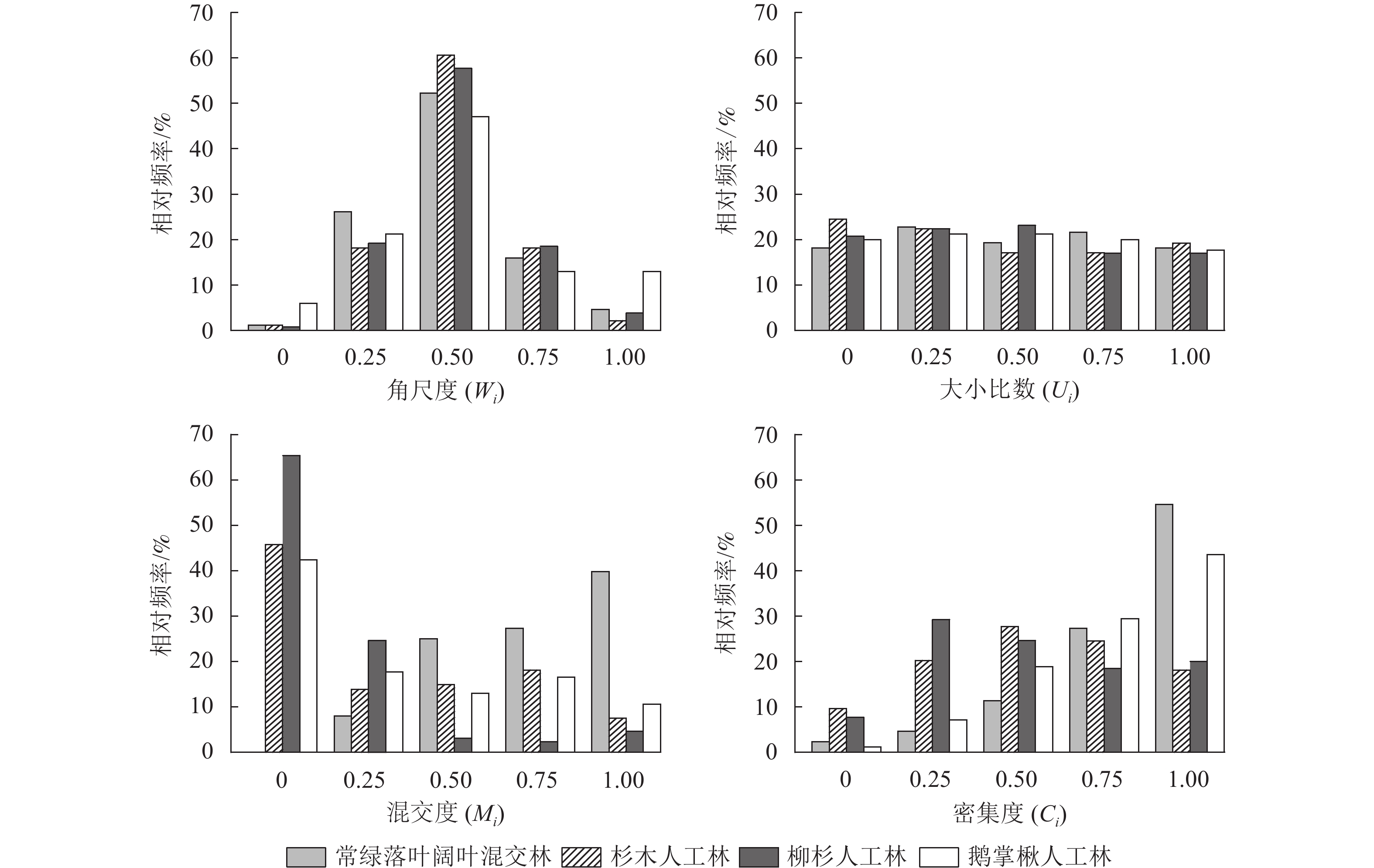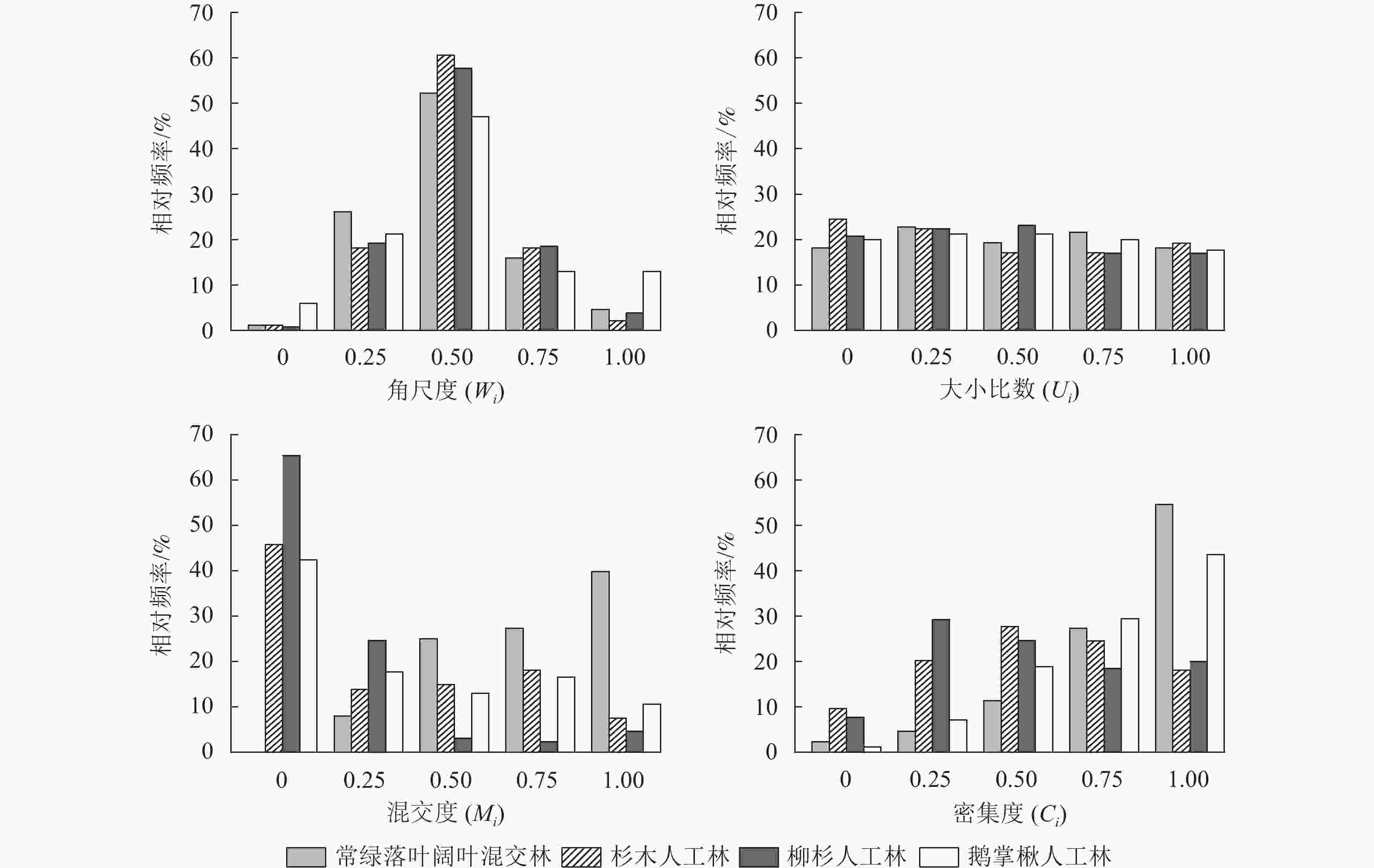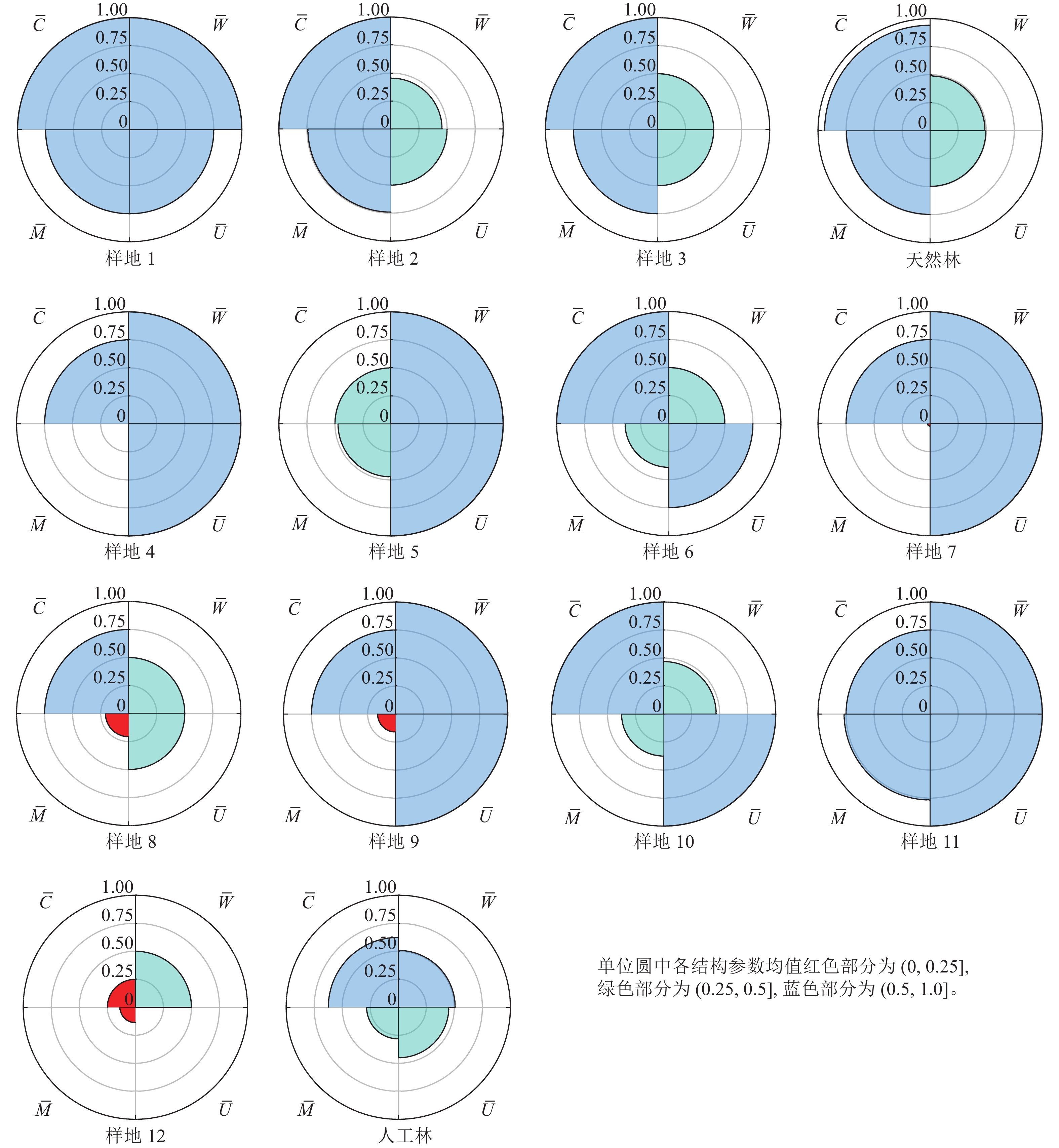-
森林对维护全球生物多样性和生态平衡至关重要,森林结构在很大程度上决定了森林的稳定性[1−3]。稳定的森林生态系统具有较高的多样性水平、丰富的林分结构、较强的碳汇能力和林木副产品生产能力。中国森林中有大面积的天然次生林和人工纯林,存在生长退化、稳定性差、结构简单、树种单一等问题。这样的林分结构显示出对森林进行保护与经营的必要性和紧迫性[4−5]。林分结构指标是分析与经营森林生态系统的重要因子,进行森林结构化经营是稳定森林生态系统的有效途径。因此,无论是天然林还是人工林的经营都应主抓结构,强调创建或维护最佳的森林空间结构[6]。应用基于相邻木空间关系的林分空间结构描述方法为森林结构化经营提供了科学基础。然而,林分空间结构参数之间既是相互独立,又是相互联系、相互制约的有机整体,只有将各个独立的林分空间结构参数整合成一个能反映结构优劣的综合指数,才能对林分空间结构状态进行整体的表达。林分状态单位圆法为综合评价林分空间结构提供了新方法[7]。
金子山国有林场位于湖北省恩施土家族苗族自治州西南部。林场内有大面积的天然混交林,植被类型为典型的亚热带常绿落叶阔叶混交林,树冠层以高大的落叶树种为主,中层以常绿树种为主,沟谷和中坡地区有密集的低矮竹林。同时林场内有多种人工林,包括杉木Cunninghamia lanceolata、柳杉Cryptomeria japonica var. sinensis、鹅掌楸Liriodendron chinense等,这些具有重要的生态和经济价值[8−10]。目前,众多学者采用结构参数的均值,一元分布或二元分布所形成的单水平、单层次或两水平形式量化描述林分空间结构特征[11−15],但关于天然林、人工林空间结构特征综合评价较少,且不同起源、不同优势树种组成的森林类型会形成不同的林分空间结构,这些空间结构的差异势必会影响森林发展与科学经营技术的制定。因此,本研究以湖北省金子山国有林场4种典型林分类型为研究对象,结合林分空间结构参数与单位圆法,构建林分空间结构综合评价指数,对不同林分类型的林分空间结构进行评价与比较,旨在明确各种森林类型的林分空间结构,为区域林分优化经营和森林质量精准提升提供科学指导。
-
研究区位于湖北省利川市金子山国有林场,中心位置地理坐标为30°17′17″N,109°02′58″E,地处武陵山脉与巫山山脉结合部,属云贵高原向东北延伸部分。该区属典型的亚热带大陆性季风湿润气候,年平均气温为12.7 ℃,年降水量为1 350.0~1 600.0 mm,降水量季节分布不均匀,无霜期为225.0~235.0 d,夏季高温多雨,冬季温暖湿润,年均日照时数为1 250.0~1 350.0 h。该地区土壤类型在低海拔多为黄棕壤,随着海拔升高而逐渐变为棕壤。林场内植被资源丰富,主要有天然林和人工林两大植被类型,天然林为230.2 hm2,占有林地的28.66%;人工林为572.9 hm2,占有林地的71.34%。天然林植被类型属亚热带山地常绿落叶阔叶混交林,是恩施州国有林场中最具有代表性和保存面积最大的典型地带性植被;人工林树种包括杉木、柳杉、日本落叶松Larix kaempferi和少量鹅掌楸等。人工林造林树种较为单一。20世纪80年代前主要造林树种为杉木和柳杉纯林,20世纪90年代后造林树种多为日本落叶松纯林。因为日本落叶松纯林对涵养水源和保持土壤肥力均为不利,所以更新造林时选择杉木、柳杉、鹅掌楸作为主要造林树种。造林时,杉木采用苗高>30 cm,地径>0.5 cm 的1年生实生苗;柳杉采用苗高>25 cm,地径>0.4 cm的 1年生实生苗;鹅掌楸采用苗高≥120 cm,地径≥0.8 cm 的2年生实生苗。在2013—2015年完成了对人工幼龄林的抚育和中龄林的抚育间伐任务。
-
2019年11月底在湖北省利川市金子山国有林场中选取4种典型森林类型:常绿落叶阔叶混交林和杉木、柳杉、鹅掌楸3种人工林,在每种森林类型典型分布区域布设3个20 m×20 m永久固定监测样地,共计12个样地(表1)。用四分法将20 m×20 m的样地连续划分为4个10 m×10 m的样方,16个5 m×5 m的样块。以样块为基本调查单元,标定样地左下角为坐标原点,南北方向为y轴,东西方向为x轴,鉴别样地内所有胸径(DBH)≥5 cm的木本植物物种,并挂牌、刷漆,进行每木检尺,测量每株木本植物个体在5 m×5 m样方内的(x、y)相对坐标值。记录树种名、冠幅、胸径、树高等林木特征值,及海拔、坡位、坡向、坡度和样地中心点经纬度等生境因子。样地四周各划定2 m的缓冲区消除边缘效应,其余区域为核心区。缓冲区内林木仅作为相邻木,而核心区内DBH≥5 cm的乔木可作为参照树和相邻木,计算林分空间结构参数。
样地编号 林分起源 林分类型 北纬(N) 东经(E) 海拔/m 坡向 平均胸径/cm 平均树高/m 林分密度/(株·hm−2) 林分龄组 1 天然林 常绿落叶阔叶
混交林30.292 3° 109.067 3° 1 468.0 东北 13.11 11.32 975 成熟林 2 30.292 1° 109.067 8° 1 481.8 东北 13.12 12.08 1275 成熟林 3 30.291 8° 109.067 6° 1 484.8 东 13.00 10.05 1200 成熟林 4 杉木林 30.295 6° 109.064 9° 1 382.0 北 22.16 17.87 875 近熟林 5 30.295 5° 109.065 0° 1 394.0 北 18.68 15.65 1150 近熟林 6 30.295 4° 109.065 2° 1 393.0 东北 16.09 13.15 1300 近熟林 7 人工林 柳杉林 30.291 7° 109.069 3° 1 446.8 北 17.92 15.15 1900 成熟林 8 30.286 5° 109.075 0° 1 382.0 北 16.57 14.95 2975 成熟林 9 30.291 3° 109.062 1° 1 555.9 东北 24.72 20.00 650 成熟林 10 鹅掌楸林 30.291 8° 109.064 6° 1 541.9 北 17.30 17.25 1100 近熟林 11 30.291 6° 109.064 2° 1 534.8 西北 19.84 15.39 825 近熟林 12 30.290 9° 109.061 9° 1 560.7 东北 17.00 20.63 1275 近熟林 Table 1. Basic information of plots different stand types
-
基于林分空间结构单元而建立的由4个空间结构参数构成的参数体系(表2)已成为分析林分结构不可分割的有机整体[16−17]。角尺度分布反映的是林分中林木个体的分布格局,基于角尺度可将森林群落中的林木划分为3种结构体,依次对应 5 株树组成的随机体、均匀体和聚集体[18−19];大小比数分布反映林分中林木的分化程度[20];混交度分布则反映林分中不同树种的隔离程度[21];密集度分布反映林分中林木的树冠密集程度[22]。对于任意1株参照树i (i = 1,2,3$,\cdots, $N)和它的4株最近相邻木j ( j =1,2,3,4),其空间结构状态(ωi)计算通式[6]为:
取值 林分空间结构参数 取值 林分空间结构参数 角尺度(Wi) 大小比数(Ui) 混交度(Mi) 密集度(Ci) 角尺度(Wi) 大小比数(Ui) 混交度(Mi) 密集度(Ci) 0.00 非常均匀 优势 零度混交 非常稀疏 0.75 聚集 劣势 高度混交 密集 0.25 均匀 亚优势 弱度混交 稀疏 1.00 非常聚集 绝对劣势 完全混交 非常密集 0.50 随机 中庸 中度混交 中等密集 Table 2. Spatial structure parameters of forest stands
其中:Vj为离散型变量,取值为0或1;ωi的5种可能取值分别为0、0.25、0.50、0.75、1.00。
零元分布是以某一指标均值说明林分整体在某一方面的平均状态特征;一元分布以5个取值等级上的频率分布详细阐述林分单方面结构状态特征[23−24]。本研究调查样地空间结构参数结果见表3。通过计算4种不同林分类型的角尺度(Wi)、大小比数(Ui)、混交度(Mi)和密集度(Ci)均值(分别记为$\overline W $、$\overline U $、$\overline M $、$\overline C $),并且绘制一元分布图,可以反映林分水平分布格局、分化程度、混交程度和密集程度等特征。
样地编号 林分类型 林层类型 林分空间结构参数均值 $\overline W $ $\overline U $ $\overline M $ $\overline C $ 1 常绿落叶阔叶混交林 复层 0.481±0.207 0.481±0.360 0.750±0.230 0.963±0.297 2 复层 0.455±0.181 0.509±0.350 0.741±0.231 0.912±0.296 3 复层 0.530±0.214 0.500±0.341 0.750±0.280 0.947±0.318 4 杉木人工林 单层 0.478±0.167 0.457±0.396 0.000±0.000 0.533±0.295 5 单层 0.491±0.173 0.420±0.367 0.473±0.322 0.347±0.283 6 单层 0.529±0.183 0.488±0.353 0.390±0.355 0.791±0.283 7 柳杉人工林 单层 0.506±0.175 0.466±0.360 0.023±0.073 0.615±0.211 8 单层 0.524±0.184 0.497±0.334 0.208±0.300 0.573±0.284 9 单层 0.482±0.249 0.321±0.331 0.161±0.210 0.500±0.392 10 鹅掌楸人工林 单层 0.469±0.177 0.430±0.331 0.375±0.348 0.625±0.284 11 复层 0.500±0.000 0.417±0.349 0.767±0.176 0.733±0.240 12 单层 0.592±0.269 0.559±0.356 0.138±0.251 0.901±0.137 Table 3. Spatial structure parameters of each stand type
-
林分空间结构参数角尺度、大小比数、混交度和密集度的均值分布区间均为[0,1],所以不需要进行归一化处理,但除混交度外,其余参数均不为正向指标。为便于整合结构参数,对这4个结构参数进行标准化处理,使其成为正向指标(表4)。结构参数正向化处理方法参考惠刚盈等[7]、魏红洋等[25]研究结果。
结构参数均值 评价标准 赋值 参数意义 $\overline M$ 正向指标 实测值 密集度均值越大说明林分内树种空间隔离程度越高,混交程度越好 $\overline W$ <0.475 实测值 角尺度均值为[0.475, 0.517]时,随机分布;<0.475时,均匀分布,不重新赋值;>0.517时,聚集分布,赋值0.500 [0.475, 0.517] 1.000 >0.517 0.500 $\overline U$ <0.470 1.000 大小比数均值<0.470时,赋值1.000;[0.470, 0.790]时,赋值0.750;(0.490, 0.510)时,赋值0.500;[0.510, 0.530]时,赋值0.250;>0.530时,赋值0 [0.470, 0.490] 0.750 (0.490, 0.510) 0.500 [0.510, 0.530] 0.250 >0.530 0 $\overline C$ <0.125 0 密集度均值<0.125时,赋值0;[0.125, 0.375)时,对于单层同龄林赋值0.500,复层异龄林赋值0.250; [0.375, 0.625)时,对于单层同龄林赋值0.750,复层异龄林赋值0.500;[0.625, 0.875)时,对于单层同龄林赋值1.000,复层异龄林赋值0.750;>0.875时,对于单层同龄林赋值0.250,复层异龄林赋值1.000 [0.125, 0.375) 0.500/0.250 [0.375, 0.625) 0.750/0.500 [0.625, 0.875] 1.000/0.750 >0.875 0.250/1.000 Table 4. Stand comprehensive evaluation index and assignment
-
惠刚盈等[5, 7]的单位圆法和林分空间结构综合评价指数(FSS)既能直观反映评估对象在各指标上的相对优劣程度,又能比对最优林分状态,π值法则对评价对象作出整体性评价,故本研究采用此方法对林分空间结构进行综合评价。
其中:m表示4个结构参数;Rk表示第k个结构参数正向指标值;$R^2 = \displaystyle \sum\limits_{k = 1}^m {R_k^2} $。
-
4种林分类型的结构参数均值(表5)表征了林分单方面的整体结构特征。从角尺度均值来看,4种林分的角尺度均值($\overline W $)之间无显著性差异,其中,常绿落叶阔叶混交林、杉木人工林、柳杉人工林均值为[0.492,0.514],整体呈随机分布,鹅掌楸人工林整体呈轻微聚集分布。4种林分类型大小比数均值($\overline U $)结果无显著性差异,常绿落叶阔叶混交林的林木整体处于中庸状态,而杉木人工林、柳杉人工林与鹅掌楸人工林的林木处于相对优势状态。混交度均值($\overline M $)表明:常绿落叶阔叶混交林与其他林分间存在极显著差异(P<0.01),该林分整体混交良好,柳杉人工林中不同种的林木最少。杉木人工林和柳杉人工林密集度均值($\overline C $)之间差异不显著,其他林分密集度均值间呈极显著差异(P<0.01),常绿落叶阔叶混交林林分密集度达0.941,冠层连接紧密,林木生长相互竞争激烈。杉木林密集度最低,冠层中度密集,林木有一定生长空间。
林分类型 林分空间结构参数均值 $\overline W $ $\overline U $ $\overline M $ $\overline C $ 常绿落叶阔叶混交林 0.492±0.202 a 0.497±0.346 a 0.747±0.247 a 0.941±0.332 a 杉木人工林 0.505±0.176 a 0.460±0.365 a 0.319±0.349 b 0.557±0.301 c 柳杉人工林 0.514±0.188 a 0.467±0.344 a 0.140±0.251 c 0.563±0.290 c 鹅掌楸人工林 0.529±0.216 a 0.485±0.348 a 0.338±0.359 b 0.768±0.027 b 说明:不同字母表示同一参数在不同林分类型间差异极显著(P<0.01)。 Table 5. Mean values of stand spatial structure parameters
-
由图1可知:所有林分的角尺度一元分布都呈正态分布,随机木个体的占比均为最高。杉木人工林中随机木数量占比最大,达60.64%;鹅掌楸人工林中随机木占比最少,为47.06%;均匀木占比最多的林分是常绿落叶阔叶混交林,为27.27%,占比最少的是杉木人工林,为19.15%;聚集木占比最多的是鹅掌楸林,为25.88%,杉木林占比最少。
各林分大小比数等级林木比例整体上比较接近,林分中不同优势度等级个体比例均接近20%。但5种林分间存在一定差异,杉木人工林优势木(Ui=0.00)比例显著高于其他林分,达24.47%,而杉木人工林的绝对劣势木(Ui=1.00)也拥有最高的占比。4种林分类型中处于亚优势等级(Ui=0.25)的林木个体数量比例最为接近。
柳杉人工林中主要以目标树与4株同种伴生(Mi=0.00,65.38%)和伴生有1种不同种林木(Mi=0.25,24.62%)的林木为主,其余混交状况林木相对较少,说明林分整体混交程度低。柳杉人工林、鹅掌楸人工林和杉木人工林中同样也是以同种组成的空间结构单元为主,混交程度低的林木(Mi=0.00、0.25)分别占对应林分总株数的90.00%、60.00%和59.57%,其余混交等级林木株数相对较少。常绿落叶阔叶混交林中39.77%的林木周围均为异种林木,混交较好林木(Mi=0.75、1.00)占总株数的67.05%,林分混交度最高。
从林分整体密集度分布来看,常绿落叶阔叶混交林中林木处于非常密集(Ci=1.00)状态的林木比例最高,达54.55%,其次是鹅掌楸人工林,这2种林分中处于很密集状态,Ci=0.75的林木占比分别达27.27%和29.41%。在稀疏状态以下(Ci=0、0.25)的林木比例都很低,分别仅为6.82%和8.24%。柳杉人工林中处于稀疏状态(Ci=0.25)的林木比例最高,达29.23%。杉木人工林中处于非常密集(Ci=1.00)状态的林木比例最低,仅为18.09%,而在非常稀疏(Ci=0.00)状态下的林木比例最高,为9.57%。
-
从表6可见:经过正向化处理后的4个结构参数范围更大,最大值可以达1.00,最小值因结构参数不同而不同。角尺度最小值与处理前相同,出现在常绿落叶阔叶混交林中;大小比数最小值为0;密集度最小值为0.25,出现在鹅掌楸人工林中;混交度最小值为0,出现在杉木人工林中。
样地编号 林分空间结构参数均值/正向处理结果 综合评价指数(FSS) 单位圆面积(S) $\overline W $/R1 $\overline U $/R2 $\overline M $/R3 $\overline C $/R4 1 0.481/1.000 0.481/0.750 0.750/0.750 0.963/1.000 0.781 2.452 2 0.455/0.455 0.509/0.500 0.741/0.741 0.912/1.000 0.502 1.576 3 0.530/0.500 0.500/0.500 0.750/0.750 0.947/1.000 0.516 1.620 天然林 0.489 0.497 0.747 0.941 0.600 1.884 4 0.478/1.000 0.457/1.000 0/0 0.533/0.750 0.641 2.013 5 0.491/1.000 0.420/1.000 0.473/0.473 0.347/0.500 0.618 1.941 6 0.529/0.500 0.488/0.750 0.390/0.390 0.791/1.000 0.491 1.542 7 0.506/1.000 0.466/1.000 0.023/0.023 0.615/0.750 0.641 2.013 8 0.524/0.500 0.497/0.500 0.208/0.208 0.573/0.750 0.276 0.867 9 0.482/1.000 0.321/1.000 0.161/0.161 0.500/0.750 0.647 2.032 10 0.469/0.469 0.430/1.000 0.375/0.375 0.625/1.000 0.590 1.853 11 0.500/1.000 0.417/1.000 0.767/0.767 0.733/0.750 0.788 2.474 12 0.592/0.500 0.559/0.000 0.138/0.138 0.901/0.250 0.083 0.261 人工林 0.508 0.451 0.282 0.624 0.531 1.667 Table 6. Comprehensive evaluation of stand structure status
将所调查样地正向化处理后的结构参数用单位圆展示,林分优劣程度则可以用FSS和单位圆面积大小(S=πFSS)直接评定(图2)。本研究中单位圆面积前3位样地依次是:鹅掌楸人工林11号样地(S=2.474),常绿落叶阔叶混交林1号样地(S=2.452),柳杉林人工林9号样地(S=2.032);面积最小的是鹅掌楸人工林12号样地(S=0.261),该样地内曾有过严重的人为砍伐,林木个体稀疏,结构遭到一定破坏。常绿落叶阔叶混交林2、3号样地及柳杉人工林8号样地的林木生长优势不明显;杉木人工林4、5号样地,柳杉人工林7、9号样地,鹅掌楸人工林10、11号样地的林分整体具有较好的生长势。常绿落叶阔叶混交林1、2、3号样地林木对空间利用很充分,而对于人工同龄林而言,杉木人工林6号样地及鹅掌楸人工林10号样地的林分中大部分林木空间被利用充分,但还有一定潜在可利用空间,有利于林木生长。各林分类型FSS从大到小依次为常绿落叶阔叶混交林(0.600)、杉木人工林(0.583)、柳杉人工林(0.521)、鹅掌楸人工林(0.487),表明常绿落叶阔叶混交林有较好的林分结构状态,综合评价效果优于其余3种林分类型。从林分起源来看,常绿落叶阔叶混交林的整体结构状态优于人工林。综合来看,常绿落叶阔叶混交林中林木树种组成丰富,混交程度明显高于各类型人工林,且林冠层连续覆盖,空间资源利用效率明显高于人工林。
-
群落的空间结构特征与群落的演替阶段密切相关。群落处于演替顶级阶段时,林分趋向于较高的混交等级,空间分布呈现随机格局,物种通过竞争占据着多样化的生态位,资源利用充分有效[26−27]。本研究中常绿落叶阔叶混交林、杉木人工林和柳杉人工林林木水平分布格局均为随机分布。鹅掌楸人工林整体呈轻微聚集分布,这可能是由于种源扩散限制植物种群早期易形成同种聚集的分布形式,亦或是人为干扰后树木死亡造成的较大林隙导致林分格局的转变,但随机分布是树木生长竞争、林分演替适应环境异质性的结果[28]。研究发现:杉木人工林、柳杉人工林和鹅掌楸人工林林木虽处于相对优势状态,但林分混交度显著低于常绿落叶阔叶混交林,这也是人工造林树种单一、空间结构较简单的突出体现。张连金等[29]对北京九龙山侧柏Platycladus orientalis人工林研究也发现:处于演替早期阶段的林分混交度低、大小分化不明显且呈均匀分布状态,与本研究结果类似。杉木人工林、柳杉人工林与鹅掌楸人工林密集程度均小于常绿落叶阔叶混交林,说明在常绿落叶阔叶混交天然林中林分整体对空间资源的利用很充分。鹅掌楸人工林由于冠幅较大,所以树木也处于相对拥挤状态,但还未充分利用空间资源。杉木、柳杉的自身特性是冠幅较小,部分样地的林木栽植密度较高,所以冠层连接较紧密,空间利用资源较为充分。林木对空间的利用是动态变化的。随着林分生长和演替变化,林木高度、各层林木数量和高度逐渐调整,垂直空间利用率也发生变化。在天然林生长过程中,林分空间结构和空间利用发生动态变化,达到一定密度范围后生长量受到抑制,在有限的空间内将逐渐被“合理布置”[30],因此在常绿落叶阔叶混交林中林木整体处于中庸状态,表明林木个体对空间资源的占有程度比较一致,处于健康稳定的生长过程中。
-
在以往的研究中,林分状态综合评价结果采用列表与文字表达,如层次分析法[31]、随机森林、多目标决策法[32]等基于统计学的综合评价法在定性或定量评价森林可持续性、经营措施、森林火灾等方面发挥了重要作用,但这些方法存在评价指标不够客观,评价方法主观性强,指标权重计算复杂等不足,最终导致评价结果缺乏直观可比性和决策可视化[33]。本研究将调查样地的正向化处理后结构参数用单位圆可视化表达,直观地展现了指标参数的数量关系与林分优劣程度。常陈豪等[34]用林分状态单位圆分析比较了不同间伐强度对信阳市商城县黄柏山林场黄山松Pinus taiwanensis人工林林分状态的影响,客观呈现了间伐后各个林分的优劣程度。本研究中鹅掌楸人工林11号样地和常绿落叶阔叶混交林1号样地单位圆面积最大,各项指标参数相对饱满,林分结构状态良好,其余样地单位圆面积相对较小。结构参数的最小影响因子决定了整体的优劣[35]。根据利比希最小因子定律可对部分林分提出结构优化建议。金子山国有林场中杉木人工林(4号样地)、柳杉人工林(7、9号样地)结构状态相对良好,但混交度较差,是林分健康稳定的短板,可适当补植乡土树种、珍贵阔叶树种,增加多样性;鹅掌楸人工林12号样地林分结构最差,树种组成单一,林木整体生长处于劣势,且呈现聚集、拥挤的生长状态,因此需要多措并举提升林分状态均衡性,包括调整林分密度、水平分布格局、单株择伐等。赵文菲等[36]对湖南平江县芦头实验林场杉木公益林采用结构方程模型进行了林分空间结构综合评价,发现杉木公益林整体处于随机及近似随机分布状态,树种混交程度低,林分中等程度拥挤,透光率一般,与本研究结论相似。常绿落叶阔叶混交林表现出较好的林分结构状态,这主要是因为天然常绿落叶阔叶混交林物种繁多,组成复杂,林分层次丰富,对空间利用率高,林分结构稳定,在保持生态平衡、发挥森林功能效益方面要强于同龄纯林尤其是针叶林[37]。综上所述,林分结构优化可参照单位圆各结构参数大小,依次制订经营策略,促进林分均衡发展。但本研究仅对林分结构状态评价进行了有限的研究,多指标体系的完善及权重分析需要不断探索和完善,需根据具体的评价对象选择合适的综合评价方法。此外,研究地点、样地质量、样地数量等因素的局限性,会对研究结果产生一定影响。
-
本研究结果直观展现了现实林分状态的优劣以及各指标的好坏程度。从林分起源来看,金子山国有林场的天然林整体结构状态优于人工林。4种典型林分中常绿落叶阔叶混交林结构状态良好,林木随机分布,生长稳定,树种混交良好,树冠连续覆盖,空间利用充分,整体优于其余3种人工林。对人工林或结构较差的林分,如鹅掌楸人工林,大多混交度较低,林木呈微聚集分布,因此可适当抚育间伐,补植乡土树种,增加物种多样性,优化林分结构,促进人工林生态系统的健康稳定。对天然林林分应健全经营保护管理体系,可参照顶级演替的天然林林分结构,合理调整林分结构,以精准提升林分质量。
Comprehensive evaluation of spatial structure of four typical forest stands in Jinzishan state-owned forest farm
doi: 10.11833/j.issn.2095-0756.20240162
- Received Date: 2024-02-01
- Accepted Date: 2024-05-24
- Rev Recd Date: 2024-05-21
- Available Online: 2024-09-25
- Publish Date: 2024-09-25
-
Key words:
- Jinzishan state-owned forest farm /
- stand spatial structure /
- structure indicators /
- unit circle method /
- comprehensive evaluation
Abstract:
| Citation: | YUAN Zixin, GUO Qiuju, AI Xunru, et al. Comprehensive evaluation of spatial structure of four typical forest stands in Jinzishan state-owned forest farm[J]. Journal of Zhejiang A&F University, 2024, 41(5): 928-938. DOI: 10.11833/j.issn.2095-0756.20240162 |












 DownLoad:
DownLoad:
